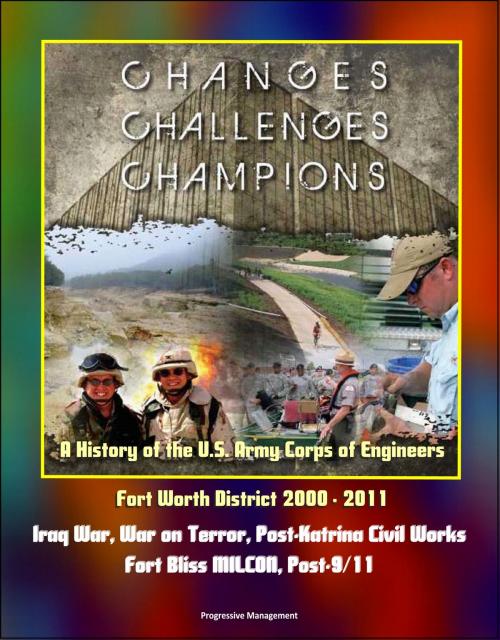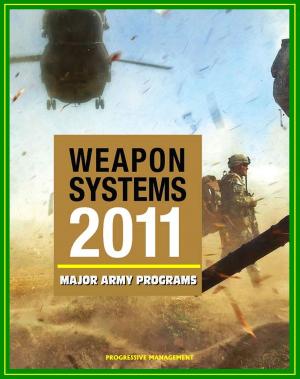Changes, Challenges, Champions: A History of the U.S. Army Corps of Engineers Fort Worth District 2000 - 2011 - Iraq War, War on Terror, Post-Katrina Civil Works, Fort Bliss MILCON, Post-9/11
Nonfiction, Science & Nature, Technology, Engineering, Civil, History, Military| Author: | Progressive Management | ISBN: | 9781310511639 |
| Publisher: | Progressive Management | Publication: | October 8, 2014 |
| Imprint: | Smashwords Edition | Language: | English |
| Author: | Progressive Management |
| ISBN: | 9781310511639 |
| Publisher: | Progressive Management |
| Publication: | October 8, 2014 |
| Imprint: | Smashwords Edition |
| Language: | English |
Created in the aftermath of an iconic flood in 1949, the Fort Worth District primarily focused on flood control and the construction of large dams during its first decade. In the 1960s and 1970s the District became more involved in watershed management and restoring wetlands. In the 1980s the Fort Worth District saw an increase in military construction. And the Water Resources Development Act of 1990 established environmental protection as a primary mission for the Corps of Engineers, which the District had already been doing throughout the prior decade.
The book is organized into five chapters and follows a roughly chronological narrative. The first chapter begins in early 2000, as Colonel James S. Weller relinquishes command to Colonel Gordon Wells, who discovers the true size and scope of the District's military and civil works responsibility as he leads the Fort Worth District into the twenty-first century. The chapter covers the District's organization as it existed from 2000 to 2002, and focuses primarily on civil works and lake operations, which dominated the District project portfolio during that time. It concludes with the Canyon Lake Flood of July 2002, which carved a geologically significant new gorge below the dam's emergency spillway. Chapter 2 begins with 9/11 and the District's response to the Global War on Terror, and then recounts the story of USACE's Forward Engineers Support Teams (FESTs) as well as Colonel Wells' deployment to Iraq and the early nation-building work of Task Force Fajr and Task Force RIO in 2003. The third chapter picks up after Wells and Task Force Fajr return home in 2003. It highlights USACE's regionalization and transformation efforts, followed by the massive military construction (MILCON) projects at Fort Bliss in El Paso, Joint Base San Antonio, and elsewhere within the District from 2005 to 2011, which were legally mandated by the Base Realignment and Closure Commission of 2005. Chapter 4 focuses on the District's Emergency Operations since the 2002 Canyon Lake Flood, with Branch Chiefs Paul Krebs and then Tony Semento leading the recovery and relief teams through such notable natural disasters as Hurricanes Katrina and Rita in 2005, the Central Texas Floods of 2007, and the tornado outbreak of April and May 2011, among other events. The fifth and final chapter deals with the District's new emphasis on civil works in a post-Katrina environment, such as the Dallas Flood-way Extension (DFE), the Central City Project in Fort Worth, and the Mission Reach in San Antonio, as the wars in Iraq and Afghanistan slowly wind down and the great MILCON and BRAC projects are completed on schedule.
Contents: Foreword * Acknowledgments * Preface * Chapter 1 - The Fort Worth District Enters the Twenty-First Century * Chapter 2 - The Fort Worth District at War. * Chapter 3 - Wartime Military Construction in the Fort Worth District * Chapter 4 - Post-9/11 Emergency Operations * Chapter 5 - War-end Civil Works and District Changes * Appendix I - Timeline of the Fort Worth District * Appendix II - Fort Worth District Commanders * Appendix III - Distinguished Civilian Awardees * Appendix IV - Commonly Used USACE Fort Worth District Acronyms * Endnotes * A Note About Sources * Select Bibliography
Created in the aftermath of an iconic flood in 1949, the Fort Worth District primarily focused on flood control and the construction of large dams during its first decade. In the 1960s and 1970s the District became more involved in watershed management and restoring wetlands. In the 1980s the Fort Worth District saw an increase in military construction. And the Water Resources Development Act of 1990 established environmental protection as a primary mission for the Corps of Engineers, which the District had already been doing throughout the prior decade.
The book is organized into five chapters and follows a roughly chronological narrative. The first chapter begins in early 2000, as Colonel James S. Weller relinquishes command to Colonel Gordon Wells, who discovers the true size and scope of the District's military and civil works responsibility as he leads the Fort Worth District into the twenty-first century. The chapter covers the District's organization as it existed from 2000 to 2002, and focuses primarily on civil works and lake operations, which dominated the District project portfolio during that time. It concludes with the Canyon Lake Flood of July 2002, which carved a geologically significant new gorge below the dam's emergency spillway. Chapter 2 begins with 9/11 and the District's response to the Global War on Terror, and then recounts the story of USACE's Forward Engineers Support Teams (FESTs) as well as Colonel Wells' deployment to Iraq and the early nation-building work of Task Force Fajr and Task Force RIO in 2003. The third chapter picks up after Wells and Task Force Fajr return home in 2003. It highlights USACE's regionalization and transformation efforts, followed by the massive military construction (MILCON) projects at Fort Bliss in El Paso, Joint Base San Antonio, and elsewhere within the District from 2005 to 2011, which were legally mandated by the Base Realignment and Closure Commission of 2005. Chapter 4 focuses on the District's Emergency Operations since the 2002 Canyon Lake Flood, with Branch Chiefs Paul Krebs and then Tony Semento leading the recovery and relief teams through such notable natural disasters as Hurricanes Katrina and Rita in 2005, the Central Texas Floods of 2007, and the tornado outbreak of April and May 2011, among other events. The fifth and final chapter deals with the District's new emphasis on civil works in a post-Katrina environment, such as the Dallas Flood-way Extension (DFE), the Central City Project in Fort Worth, and the Mission Reach in San Antonio, as the wars in Iraq and Afghanistan slowly wind down and the great MILCON and BRAC projects are completed on schedule.
Contents: Foreword * Acknowledgments * Preface * Chapter 1 - The Fort Worth District Enters the Twenty-First Century * Chapter 2 - The Fort Worth District at War. * Chapter 3 - Wartime Military Construction in the Fort Worth District * Chapter 4 - Post-9/11 Emergency Operations * Chapter 5 - War-end Civil Works and District Changes * Appendix I - Timeline of the Fort Worth District * Appendix II - Fort Worth District Commanders * Appendix III - Distinguished Civilian Awardees * Appendix IV - Commonly Used USACE Fort Worth District Acronyms * Endnotes * A Note About Sources * Select Bibliography















